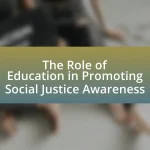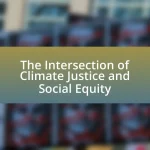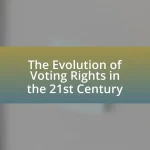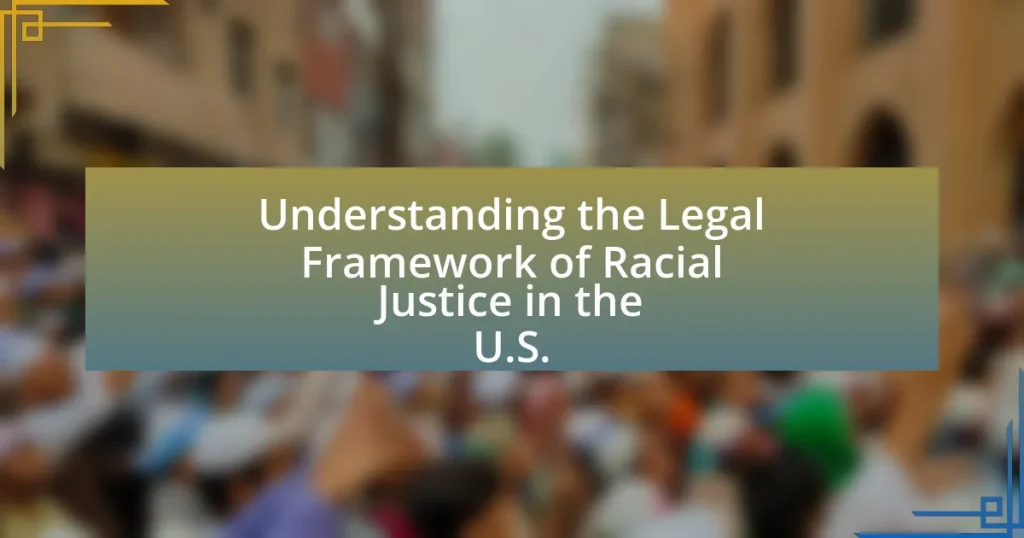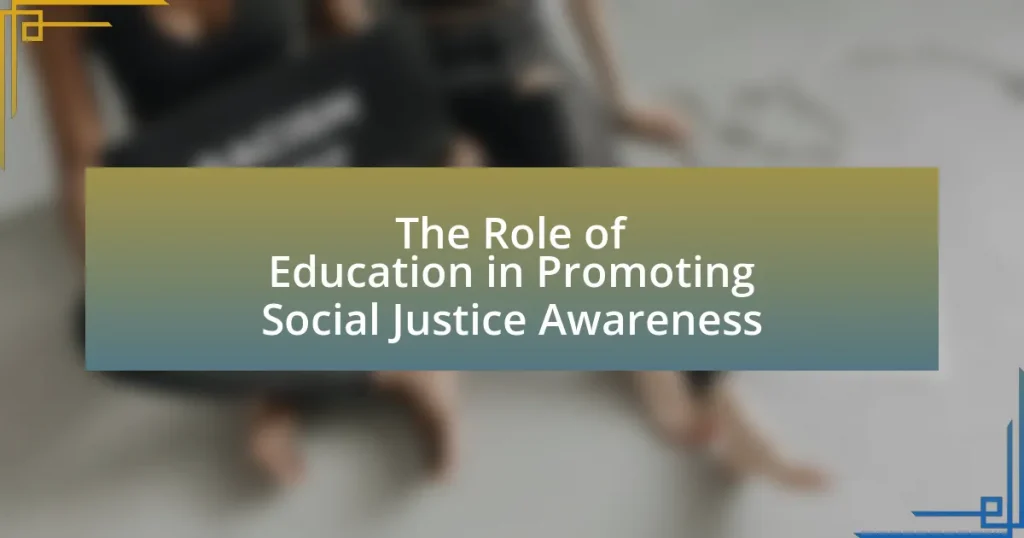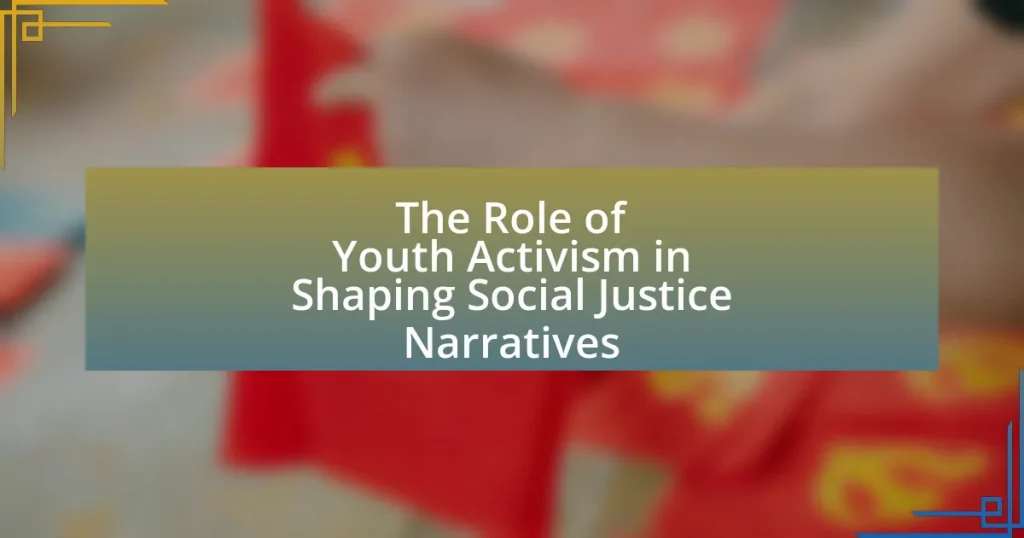Intersectionality in political movements is an analytical framework that examines how overlapping social identities—such as race, gender, class, and sexuality—interact to create distinct experiences of discrimination and privilege. This concept, introduced by Kimberlé Crenshaw, emphasizes the importance of recognizing these intersections to develop inclusive policies and practices that address the complexities of social inequalities. The article explores the emergence of intersectionality in political discourse, its historical influences, key figures associated with the framework, and its implications for political strategies and coalition-building. Additionally, it addresses the challenges intersectionality faces within political movements and offers practical steps for activists to effectively incorporate this framework into their work.

What is Intersectionality in Political Movements?
Intersectionality in political movements refers to the analytical framework that examines how various social identities, such as race, gender, class, and sexuality, intersect to create unique modes of discrimination and privilege. This concept, introduced by Kimberlé Crenshaw in the late 1980s, highlights that individuals experience oppression differently based on their overlapping identities. For instance, a Black woman may face both racial and gender discrimination, which cannot be fully understood by examining race or gender in isolation. Research has shown that intersectional approaches in political movements can lead to more inclusive policies and practices, as they address the complexities of social inequalities rather than treating them as separate issues.
How did the concept of intersectionality emerge in political discourse?
The concept of intersectionality emerged in political discourse primarily through the work of Kimberlé Crenshaw in the late 1980s, who introduced the term to address the overlapping social identities and related systems of oppression faced by individuals. Crenshaw’s analysis highlighted how traditional feminist and anti-racist frameworks often failed to consider the unique experiences of Black women, thereby demonstrating that social categories such as race, gender, and class are interconnected and cannot be examined in isolation. This foundational work laid the groundwork for intersectionality as a critical lens in political movements, influencing subsequent discussions on social justice and advocacy by emphasizing the need for inclusive approaches that recognize the complexity of individual identities and experiences.
What historical events contributed to the development of intersectionality?
The development of intersectionality was significantly influenced by the civil rights movement, feminist movements, and the emergence of critical race theory. The civil rights movement in the 1960s highlighted the interconnectedness of race, class, and gender, as activists like Angela Davis emphasized the need to address multiple forms of oppression simultaneously. Feminist movements, particularly the second wave in the 1970s, began to critique the exclusion of women of color and working-class women from mainstream feminist discourse, leading to a broader understanding of gender that included race and class. Additionally, critical race theory, which emerged in the late 1980s, provided a framework for analyzing how laws and social structures perpetuate racial inequalities, further solidifying the concept of intersectionality as a vital analytical tool for understanding complex social identities and systemic oppression.
Who are the key figures associated with the intersectionality framework?
Key figures associated with the intersectionality framework include Kimberlé Crenshaw, Patricia Hill Collins, and Angela Davis. Kimberlé Crenshaw, a legal scholar, coined the term “intersectionality” in her 1989 paper, highlighting how overlapping social identities, particularly race and gender, impact experiences of discrimination. Patricia Hill Collins expanded on these ideas in her work on Black feminist thought, emphasizing the interconnectedness of race, class, and gender. Angela Davis has also contributed significantly to intersectional analysis through her activism and scholarship, focusing on the intersections of race, gender, and class in the context of social justice movements.
Why is intersectionality important in understanding political movements?
Intersectionality is important in understanding political movements because it reveals how various social identities—such as race, gender, class, and sexuality—interact to shape individuals’ experiences and perspectives. This framework allows for a more nuanced analysis of political issues, highlighting that marginalized groups often face unique challenges that cannot be understood through a single-axis lens. For example, the experiences of Black women in the feminist movement illustrate that their struggles are distinct from those of white women or Black men, necessitating tailored approaches to advocacy and policy-making. By acknowledging these intersecting identities, political movements can create more inclusive strategies that address the specific needs of diverse communities, ultimately leading to more effective and equitable outcomes.
How does intersectionality challenge traditional political analysis?
Intersectionality challenges traditional political analysis by emphasizing the interconnectedness of social identities and their impact on power dynamics. Traditional political analysis often focuses on singular categories, such as class or race, neglecting how overlapping identities—like gender, sexuality, and disability—shape individuals’ experiences and political realities. For instance, Kimberlé Crenshaw, who coined the term “intersectionality,” illustrated how Black women face unique forms of discrimination that cannot be understood solely through the lenses of race or gender independently. This approach reveals the limitations of conventional frameworks, which may overlook the complexities of marginalized groups’ experiences, thereby advocating for a more nuanced understanding of social justice and policy-making.
What implications does intersectionality have for marginalized groups in politics?
Intersectionality significantly impacts marginalized groups in politics by highlighting the interconnected nature of social categorizations such as race, gender, and class, which create overlapping systems of discrimination or disadvantage. This framework allows for a more nuanced understanding of how various identities influence political experiences and access to power. For instance, studies show that Black women face unique challenges in political representation that differ from those experienced by white women or Black men, as evidenced by the 2018 midterm elections where Black women played a crucial role in voter turnout and candidate support, yet remained underrepresented in political offices. By acknowledging these complexities, intersectionality encourages political movements to adopt inclusive strategies that address the specific needs and voices of diverse marginalized groups, ultimately fostering a more equitable political landscape.
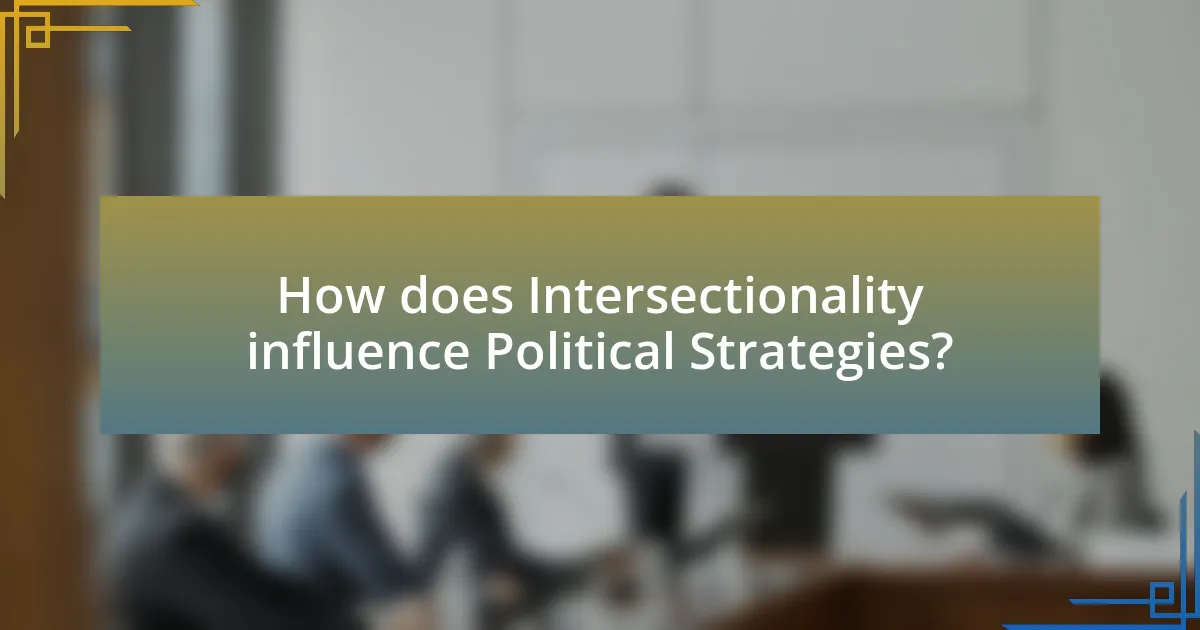
How does Intersectionality influence Political Strategies?
Intersectionality influences political strategies by emphasizing the interconnectedness of various social identities, such as race, gender, class, and sexuality, which shape individuals’ experiences and political needs. This framework encourages political movements to adopt inclusive strategies that address the diverse and overlapping issues faced by marginalized groups. For instance, the Women’s March in 2017 highlighted intersectionality by advocating for the rights of women of color, LGBTQ+ individuals, and immigrants, demonstrating that a singular focus on gender alone would overlook critical issues affecting these communities. Research by Crenshaw (1989) on the concept of intersectionality illustrates how traditional political strategies often fail to account for the complexities of identity, leading to ineffective advocacy. By integrating intersectionality into political strategies, movements can create more comprehensive policies that resonate with a broader constituency and foster solidarity among diverse groups.
What are the different ways intersectionality shapes political agendas?
Intersectionality shapes political agendas by highlighting the interconnectedness of various social identities and their impact on individuals’ experiences of oppression and privilege. This framework encourages political movements to address multiple forms of discrimination, such as race, gender, class, and sexuality, rather than focusing on a single issue. For example, the Black Lives Matter movement incorporates intersectional perspectives by advocating for racial justice while also addressing issues like police violence against LGBTQ+ individuals and economic inequality. Research by Crenshaw (1989) emphasizes that policies and political strategies must consider these overlapping identities to effectively address systemic injustices. Consequently, intersectionality leads to more inclusive and comprehensive political agendas that resonate with a broader range of constituents.
How do intersectional perspectives inform policy-making?
Intersectional perspectives inform policy-making by highlighting the interconnected nature of social categorizations such as race, gender, and class, which can lead to overlapping systems of discrimination or disadvantage. This approach enables policymakers to understand how different identities impact individuals’ experiences and needs, ensuring that policies are more inclusive and equitable. For instance, research by Crenshaw (1989) introduced the concept of intersectionality, demonstrating that women of color face unique challenges that are not addressed by policies focusing solely on race or gender. By incorporating intersectional analysis, policymakers can create targeted interventions that address the specific barriers faced by marginalized groups, ultimately leading to more effective and just outcomes.
What role does intersectionality play in coalition-building among movements?
Intersectionality plays a crucial role in coalition-building among movements by fostering inclusivity and understanding of diverse identities and experiences. This framework allows movements to recognize how overlapping social identities—such as race, gender, class, and sexuality—impact individuals’ experiences of oppression and privilege. For instance, coalitions that embrace intersectionality can address the unique challenges faced by marginalized groups, leading to more effective advocacy and solidarity. Research by Crenshaw (1989) highlights that without an intersectional approach, movements risk perpetuating the marginalization of certain groups within broader social justice efforts. Thus, intersectionality enhances coalition-building by ensuring that all voices are heard and represented, ultimately strengthening the collective impact of movements.
How can political movements effectively incorporate intersectionality?
Political movements can effectively incorporate intersectionality by actively recognizing and addressing the diverse identities and experiences of individuals within their constituencies. This involves creating inclusive platforms that prioritize the voices of marginalized groups, ensuring that policies reflect the complexities of race, gender, sexuality, and class. For instance, the Black Lives Matter movement exemplifies this approach by centering the experiences of Black women and LGBTQ+ individuals, thereby highlighting the interconnectedness of various forms of oppression. Research indicates that movements that embrace intersectionality are more successful in mobilizing support and achieving policy changes, as they resonate with a broader audience and foster solidarity among different social justice causes.
What best practices exist for integrating intersectional approaches in activism?
Best practices for integrating intersectional approaches in activism include prioritizing diverse representation, fostering inclusive dialogue, and employing a holistic analysis of social issues. Diverse representation ensures that various identities and experiences are reflected in leadership and decision-making, which enhances the effectiveness of activism. Inclusive dialogue encourages collaboration among different groups, allowing for shared knowledge and strategies that address multiple forms of oppression. A holistic analysis of social issues involves examining how various factors such as race, gender, class, and sexuality intersect, which leads to more comprehensive solutions. Research by Crenshaw (1989) highlights the importance of recognizing these intersections to effectively address systemic inequalities.
How can organizations assess their intersectional impact?
Organizations can assess their intersectional impact by employing a comprehensive framework that analyzes how various social identities interact and influence experiences of privilege and oppression. This assessment involves collecting and analyzing data on demographics, social determinants, and systemic barriers faced by different groups within the organization and its community. For instance, organizations can utilize intersectional surveys and focus groups to gather qualitative and quantitative data, allowing them to identify disparities in access to resources and opportunities. Research indicates that organizations that adopt intersectional approaches are better equipped to address inequalities, as highlighted in the study “Intersectionality Matters: A Guide to Engaging with Intersectionality in Research” by the Institute of Development Studies, which emphasizes the importance of understanding the interconnectedness of social categories in shaping individual experiences.
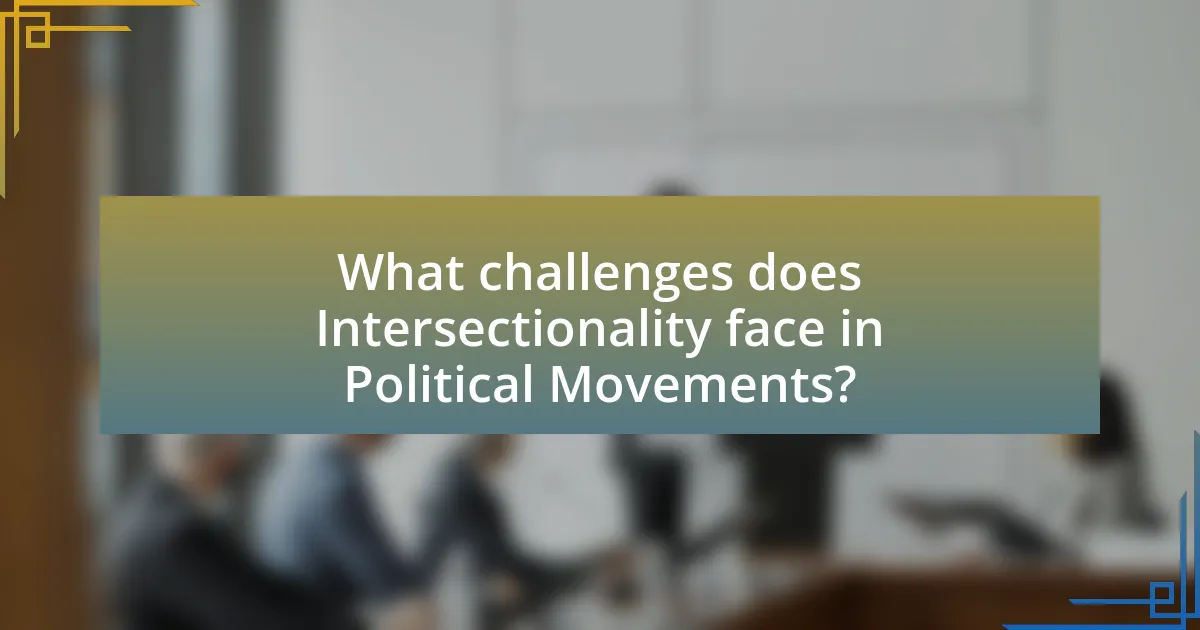
What challenges does Intersectionality face in Political Movements?
Intersectionality faces several challenges in political movements, primarily including fragmentation, misrepresentation, and lack of inclusivity. Fragmentation occurs when diverse groups within a movement prioritize their specific identities over collective goals, leading to disunity. Misrepresentation arises when dominant narratives overshadow the experiences of marginalized groups, often sidelining their issues. Additionally, lack of inclusivity can hinder the participation of individuals from various backgrounds, limiting the movement’s effectiveness and reach. These challenges are evident in historical contexts, such as the women’s suffrage movement, where the needs of women of color were often overlooked in favor of white women’s issues, demonstrating the necessity for a more integrated approach to advocacy.
What are the common misconceptions about intersectionality in politics?
Common misconceptions about intersectionality in politics include the belief that it solely focuses on identity categories, that it promotes divisiveness, and that it is a recent concept. Intersectionality actually examines how various social identities, such as race, gender, and class, interact to shape individual experiences and systemic inequalities. This framework does not create division but rather highlights the interconnectedness of different forms of oppression, as articulated by Kimberlé Crenshaw, who coined the term in 1989. Furthermore, intersectionality has historical roots in feminist and civil rights movements, demonstrating its longstanding relevance in political discourse.
How do these misconceptions hinder political progress?
Misconceptions about intersectionality hinder political progress by oversimplifying complex social issues and marginalizing diverse voices. When political movements fail to recognize the interconnectedness of various identities, such as race, gender, and class, they risk alienating groups that do not fit the dominant narrative. For example, the Women’s March in 2017 faced criticism for not adequately addressing the needs of women of color, which highlighted the limitations of a one-size-fits-all approach. This lack of inclusivity can lead to fragmented movements that struggle to achieve cohesive goals, ultimately stalling legislative and social advancements.
What resistance do intersectional movements encounter from traditional political structures?
Intersectional movements encounter significant resistance from traditional political structures primarily due to their challenge to established power dynamics and norms. Traditional political structures often prioritize singular identities and issues, which can marginalize the multifaceted experiences of individuals who face overlapping forms of discrimination, such as race, gender, and class. This resistance manifests in various ways, including the reluctance of political leaders to adopt inclusive policies, the framing of intersectional issues as divisive, and the lack of representation for diverse voices within political institutions. For instance, research by Crenshaw (1989) highlights how legal frameworks often fail to address the complexities of discrimination faced by individuals at the intersections of multiple identities, thereby reinforcing systemic inequalities.
How can intersectional movements overcome these challenges?
Intersectional movements can overcome challenges by fostering inclusive coalitions that prioritize diverse voices and experiences. By actively engaging marginalized groups, these movements can address specific needs and create tailored strategies that resonate with various communities. For instance, the Women’s March in 2017 exemplified this approach by incorporating issues such as racial justice, LGBTQ+ rights, and economic inequality, thereby broadening its appeal and effectiveness. Research indicates that inclusive movements are more successful in mobilizing support and achieving policy changes, as seen in the increased visibility and impact of intersectional advocacy in recent social justice campaigns.
What strategies can activists employ to address pushback against intersectionality?
Activists can employ education and coalition-building as strategies to address pushback against intersectionality. By educating the public and stakeholders about the principles of intersectionality, activists can clarify misconceptions and demonstrate its relevance to social justice issues. For instance, research by Crenshaw highlights how intersectionality reveals the complexities of discrimination faced by individuals with multiple marginalized identities, thus fostering a deeper understanding of systemic inequalities. Additionally, coalition-building among diverse groups can amplify voices and create a united front, making it harder for detractors to dismiss intersectional perspectives. This approach has been effective in various movements, such as the Women’s March, which emphasized inclusivity and intersectional issues, thereby countering resistance and fostering solidarity.
How can education and awareness promote a better understanding of intersectionality?
Education and awareness can promote a better understanding of intersectionality by providing individuals with the knowledge and tools to recognize and analyze the interconnected nature of social identities and systems of oppression. Through structured curricula and community programs, education can highlight how factors such as race, gender, class, and sexuality intersect to shape experiences of privilege and discrimination. For instance, studies have shown that educational initiatives focused on social justice increase empathy and critical thinking skills, enabling individuals to engage more thoughtfully with complex social issues. This understanding is essential for fostering inclusive political movements that address the diverse needs of marginalized communities.
What practical steps can activists take to implement intersectionality in their work?
Activists can implement intersectionality in their work by actively engaging with diverse communities and incorporating their unique experiences into advocacy efforts. This involves conducting thorough research to understand the specific needs and challenges faced by marginalized groups, such as women of color, LGBTQ+ individuals, and people with disabilities. For instance, the 2017 Women’s March highlighted the importance of intersectionality by including voices from various social justice movements, demonstrating that collective action is more effective when it reflects the diversity of experiences. Additionally, activists should prioritize coalition-building with organizations that represent different identities, ensuring that their strategies are inclusive and representative. This approach not only amplifies underrepresented voices but also fosters solidarity across movements, leading to more comprehensive and effective advocacy.

